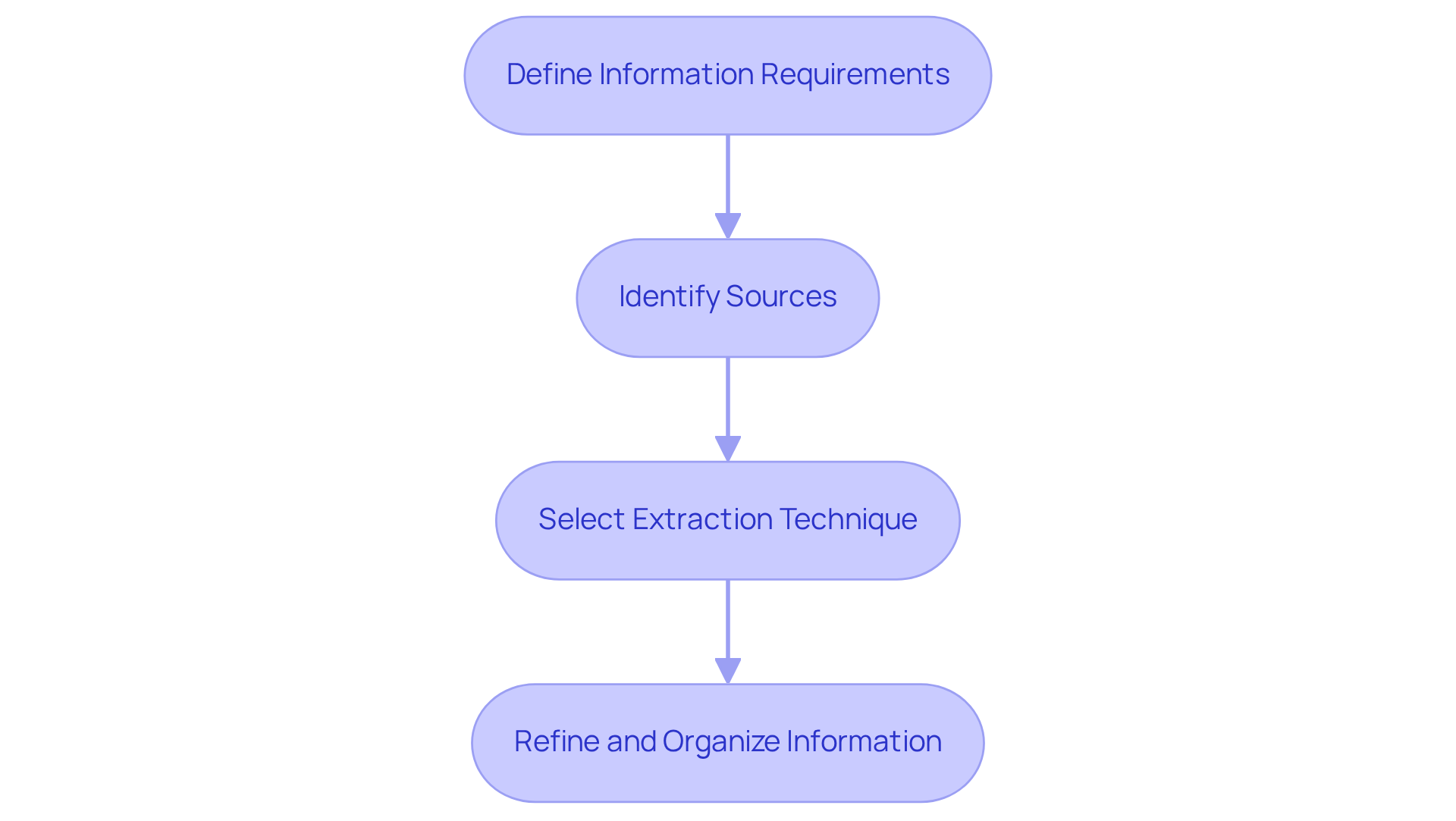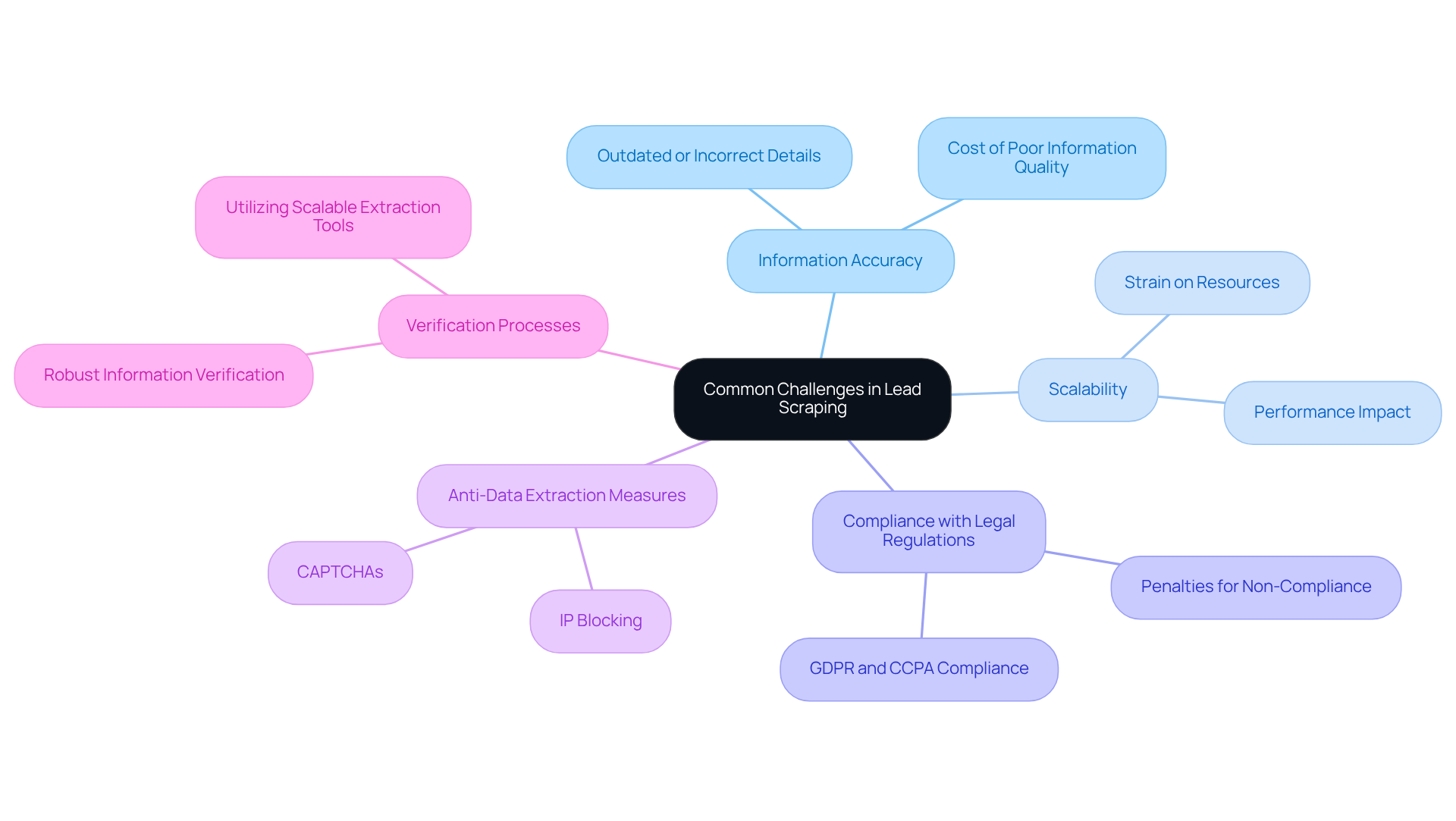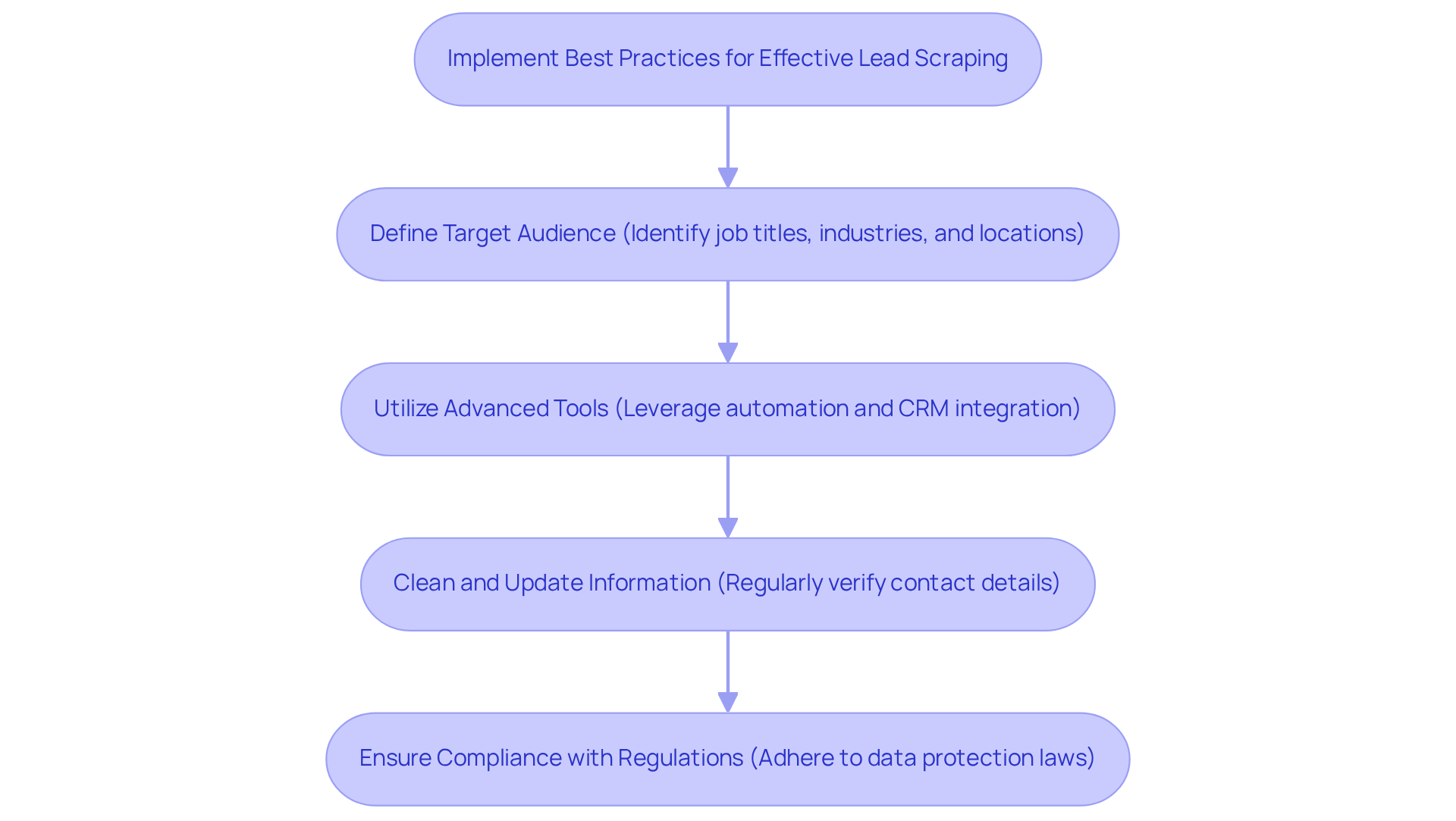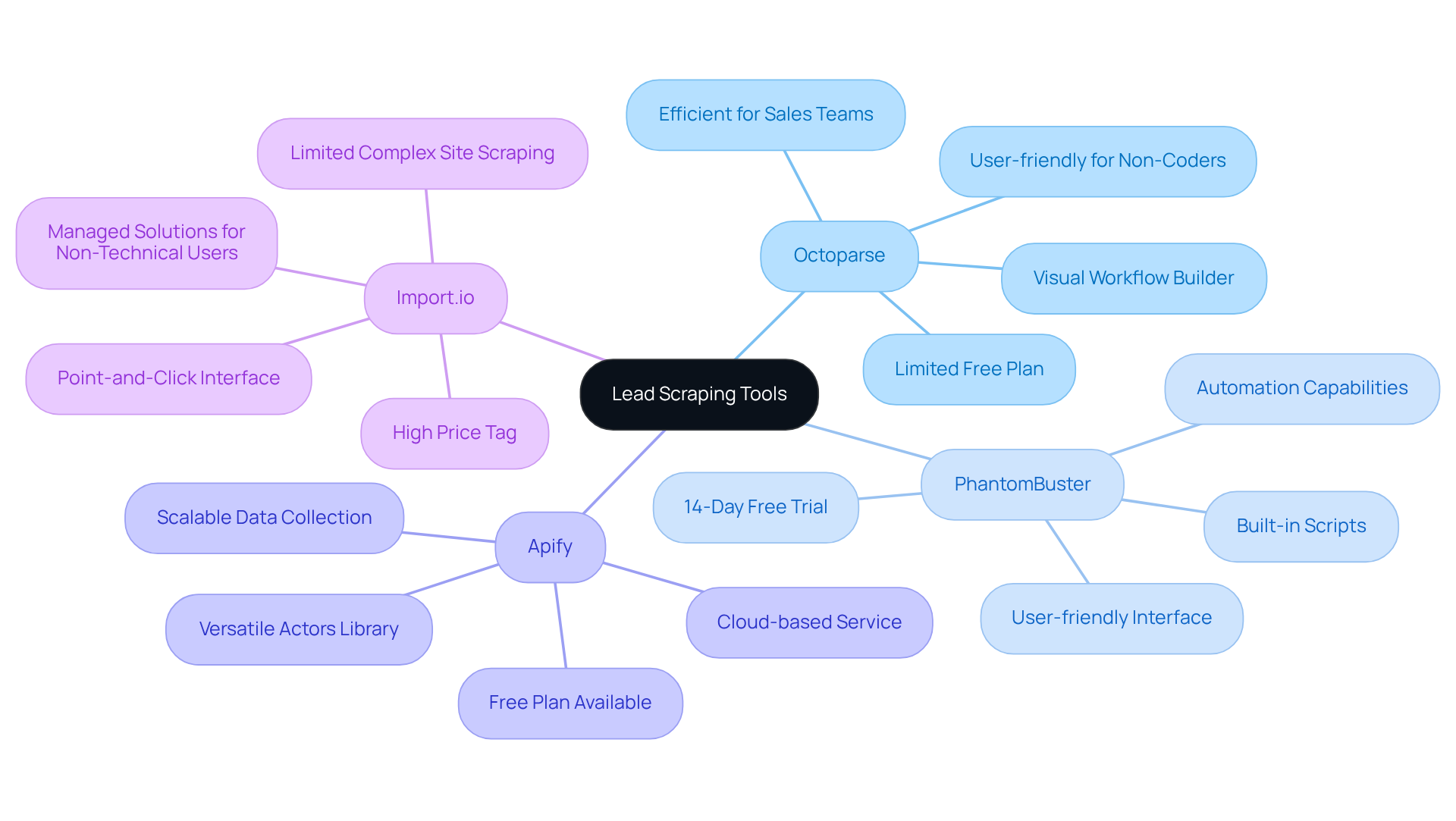Overview
This article delineates best practices for database lead scraping, underscoring its critical role in boosting sales success through the provision of accurate and actionable data on potential prospects. It adopts a structured approach to lead scraping, effectively addressing common challenges faced by sales professionals. Furthermore, it recommends advanced tools and compliance measures that collectively enhance the efficiency and effectiveness of sales outreach efforts. By implementing these strategies, sales teams can significantly improve their outreach and conversion rates.
Introduction
Database lead scraping stands as a cornerstone of modern sales strategies, empowering teams to efficiently gather valuable contact information from a multitude of online sources. This powerful technique enables organizations to significantly enhance their prospecting efforts, streamline outreach processes, and ultimately drive revenue growth. However, as the digital landscape evolves, so too do the challenges associated with lead scraping—spanning issues of data accuracy and compliance with legal regulations.
How can sales teams effectively navigate these hurdles while maximizing the benefits of database lead scraping?
Define Database Lead Scraping and Its Importance
Database lead scraping is the strategic process of extracting contact details and relevant information from diverse online sources to construct a comprehensive database of potential prospects. This practice of database lead scraping is vital for marketing teams, allowing them to identify and engage with potential clients who align with their target market criteria. By leveraging database lead scraping, organizations can enhance their opportunity generation efforts, reduce the time spent on manual information gathering, and ultimately improve their revenue efficiency. The importance of database lead scraping lies in its ability to provide accurate, up-to-date data that significantly boosts the effectiveness of sales outreach and marketing initiatives. For instance, companies employing AI-driven prospect generation tools like Websets can quickly gather enriched information from social media platforms, industry directories, and other online resources, ensuring access to a vast pool of potential clients.
The primary collection process typically involves four essential steps:
- Defining information requirements
- Identifying sources
- Selecting an extraction technique
- Refining and organizing the gathered information
This structured approach guarantees that the data collected is both relevant and actionable for sales initiatives. Additionally, it is crucial to consider legal and ethical factors when engaging in data harvesting to ensure compliance and build trust with prospective clients.
Statistics indicate that 91% of marketers prioritize client acquisition, while 41% of B2B marketers cite generating more prospects as their greatest challenge. This underscores the critical role of , particularly through database lead scraping, in addressing these challenges. Furthermore, businesses utilizing automated prospect collection tools, such as those offered by Websets, experience a significant boost in efficiency, allowing representatives to concentrate more on engaging with potential clients rather than merely collecting information. However, it is essential to remain vigilant about potential pitfalls, including ensuring information accuracy and navigating anti-scraping measures like IP blocking.
Consequently, database lead scraping emerges as a vital strategy for modern sales teams aiming to enhance their productivity and effectiveness in a competitive landscape. As Zyte, a leader in the web extraction sector, notes, "Overall, web extraction is among the quickest and most cost-effective methods to obtain vast amounts of contact information.

Identify Common Challenges in Lead Scraping
Lead scraping presents substantial advantages, yet it also introduces challenges that can hinder success. A primary concern is information accuracy; outdated or incorrect details can result in wasted efforts and missed opportunities. The cost of poor information quality can reach millions, leading to inefficiencies and lost sales. Additionally, scalability poses a challenge, as collecting large volumes of data can strain resources and impact performance. Compliance with legal regulations, such as GDPR and CCPA, is critical; non-compliance can result in penalties and reputational damage.
Websites often employ like CAPTCHAs and IP blocking, which can disrupt the data gathering process. To effectively navigate these challenges, sales teams should implement robust information verification processes and utilize scalable extraction tools, such as database lead scraping. For example, itrinity successfully scaled its lead generation from 10 emails a day to 400 a week by leveraging advanced database lead scraping tools, showcasing the potential of effective strategies.
Staying informed about legal requirements related to information gathering is essential. As Ed Umbao, Head of Content and SEO Strategist at Outscraper, emphasizes, "Your information holds hidden revenue, but only if it's complete." This underscores the importance of utilizing Websets' AI-driven information enhancement tools, which improve quality and ensure compliance. By doing so, teams can significantly boost their prospect generation efforts and overall results.

Implement Best Practices for Effective Lead Scraping
To maximize the effectiveness of database lead scraping, sales teams must adhere to several best practices. Clearly defining the target audience and the specific information required—such as job titles, industries, and geographic locations—is essential. This focused approach streamlines the extraction process and significantly enhances the relevance of the information. For instance, concentrating on specific sectors can substantially increase the likelihood of attracting interested clients, as targeted outreach leads to higher engagement and conversion rates.
Utilizing , which are equipped with features like information enhancement and automation, can further improve efficiency. Tools that seamlessly integrate with CRM systems facilitate better prospect management and tracking, allowing sales teams to focus on engaging potential customers rather than on tedious manual data entry.
Consistently cleaning and updating scraped information is crucial for maintaining accuracy and relevance. Implementing a monthly review process to verify the contact details of potential clients ensures that outreach efforts target valid prospects, minimizing wasted resources on outdated contacts.
Lastly, compliance with data protection regulations is paramount. Sales teams must secure necessary permissions and adhere to website terms of service to avoid legal complications. By implementing these best practices, companies can fully leverage the potential of database lead scraping, which leads to more effective outreach and ultimately enhances sales success.

Explore Tools and Technologies for Lead Scraping
Numerous tools and technologies for database lead scraping are available, each designed to enhance the efficiency of the process. Among the most favored choices is Octoparse, which offers a user-friendly interface that enables non-coders to gather information from websites effortlessly. This tool is particularly efficient for sales teams, allowing rapid information gathering from various sources, including social media and online directories. PhantomBuster stands out for its automation capabilities, enabling users to extract leads from social media platforms seamlessly.
Apify provides a cloud-based service ideal for large-scale extraction, allowing teams to swiftly collect vast amounts of information. Import.io focuses on converting web data into organized formats, facilitating analysis and effective use by sales teams. When selecting a lead scraping tool, marketing teams must prioritize , scalability, and integration capabilities with existing CRM systems.
Consider a marketing group utilizing Lead Scrape. They can automate the extraction of contact details from industry-specific directories, significantly reducing the time spent on manual data input. This automation not only boosts productivity but also enables teams to concentrate on developing connections with prospective clients, ultimately fostering commercial success. By leveraging the right database lead scraping tools, sales teams can enhance their outreach efforts and achieve superior results in their lead generation strategies.

Conclusion
Database lead scraping is an essential practice for sales teams aiming to enhance outreach and efficiency. By systematically extracting and organizing relevant data from various online sources, organizations can build a robust database of potential clients that aligns with their target market. This strategic approach not only streamlines the prospecting process but also significantly boosts the effectiveness of sales initiatives.
The importance of a structured lead scraping process cannot be overstated. It involves:
- Defining information requirements
- Identifying sources
- Selecting extraction techniques
- Refining the gathered data
Common challenges, such as ensuring information accuracy and navigating legal regulations, must be addressed, while best practices should be emphasized to maximize the benefits of lead scraping. Utilizing advanced tools and technologies greatly enhances efficiency, allowing sales teams to focus on building relationships rather than getting bogged down by manual data collection.
Ultimately, embracing database lead scraping and implementing the outlined best practices can transform the sales landscape for organizations. By prioritizing accurate data collection and leveraging the right technologies, sales teams can significantly improve their prospect generation efforts, leading to enhanced engagement and conversion rates. The path to sales success is paved with informed strategies and effective tools, making it imperative for teams to adapt and optimize their lead scraping techniques.
Frequently Asked Questions
What is database lead scraping?
Database lead scraping is the process of extracting contact details and relevant information from various online sources to create a comprehensive database of potential prospects.
Why is database lead scraping important for marketing teams?
It helps marketing teams identify and engage with potential clients that fit their target market criteria, enhances opportunity generation, reduces time spent on manual information gathering, and improves revenue efficiency.
How does database lead scraping improve sales outreach and marketing initiatives?
It provides accurate, up-to-date data that significantly boosts the effectiveness of sales outreach and marketing efforts.
What are the four essential steps in the database lead scraping process?
The four essential steps are: 1. Defining information requirements 2. Identifying sources 3. Selecting an extraction technique 4. Refining and organizing the gathered information
What legal and ethical factors should be considered in database lead scraping?
It is important to ensure compliance with legal standards and ethical practices to build trust with prospective clients during the data harvesting process.
What challenges do marketers face regarding prospect generation?
Statistics show that 41% of B2B marketers cite generating more prospects as their greatest challenge, highlighting the critical role of effective prospect gathering.
How can automated prospect collection tools enhance efficiency?
Tools like those offered by Websets allow businesses to collect information quickly, enabling representatives to focus more on engaging with potential clients rather than just gathering data.
What potential pitfalls should be considered when engaging in database lead scraping?
It is essential to ensure the accuracy of the collected information and navigate anti-scraping measures, such as IP blocking, to avoid disruptions.
How does web extraction compare to traditional methods of obtaining contact information?
Web extraction is considered one of the quickest and most cost-effective methods to obtain large amounts of contact information, according to industry leaders like Zyte.




